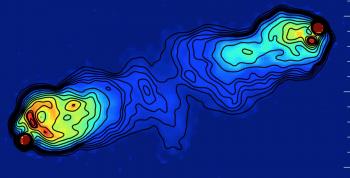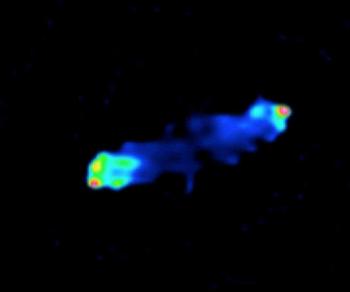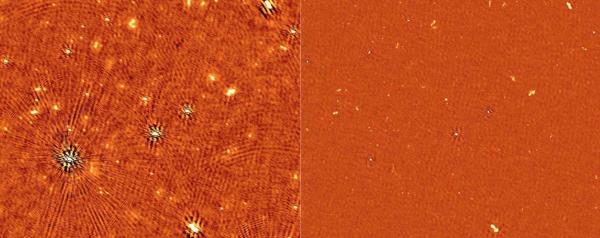Novel image processing techniques have been discussed today at the SKA Science Conference in Goa, India, as French researchers have updated the astronomy community on promising work being undertaken in France to develop new algorithms for radio astronomy, with potential applications beyond.
French teams from Observatoire de Paris, Observatoire de la Côte d’Azur, AIM Laboratory, Labex UnivEarthS, ENS Cachan and Université Paris X are actively working on state-of-the-art algorithms for calibration and deconvolution – removal of artifacts in the images- of radio astronomy observations.
Adaptive optics for radio astronomy
A French team from Observatoire de Paris led by Dr Cyril Tasse is working on developing the equivalent of "adaptive optics" for radio astronomy. Adaptive optics systems - as used in world-class optical astronomy facilities such as the VLT in Chile– measure how atmospheric turbulence affects known sources in the sky, to then deform active mirror surfaces and compensate for the turbulence, thus resulting in much sharper images. In effect, these systems almost correct the effects of the atmosphere.
"In optical astronomy, you apply this correction to the mirror. In radio-astronomy you apply the correction in the supercomputer doing the image processing", explains Dr Chiara Ferrari, Coordinator of the SKA-France organisation, in charge of coordinating the French contributions to the SKA in the period leading to the construction phase in 2018
While self-calibration tools already exist in radio astronomy, the French team has developed next-generation “direction-dependent” algorithms that cope with the changing nature of the ionosphere over the observed portion of the sky. These algorithms measure how the signal from known sources in the sky in the area of observation is affected by the turbulence from the ionosphere, and then apply a correction in post processing to cancel those effects. The team recently tested their algorithm on observations of the international LOFAR telescope (from the LOFAR Surveys project, lead by Prof Röttgering), producing very promising results.
In collaboration with the group of Prof. Oleg Smirnov in South Africa, this new generation algorithms were also recently used to process the first light image of MeerKAT, one of the SKA precursor telescopes located in South Africa, resulting in a very detailed image where some 7,000 previously unknown galaxies were discovered.
Production of “super-resolution” images
In parallel, researchers from Observatoire de la Côte d’Azur and AIM Laboratory have been working on developing new image reconstruction tools. Radio-astronomy observations use Fourier Transforms to create images from observed data. In order to reproduce the image that best model the observed sky, astronomers need to get rid of artifacts in the images caused by the telescope itself, through an operation called “deconvolution”.
Classical deconvolution algorithms assume that the sky is populated by sources whose shape can be described mathematically by one set of functions. The work developed by the French teams is based on assuming a wider set of functions. Results obtained so far show that this new tools produces better angular resolution images (capacity to see more details) and an increased sensitivity (capacity to detect faint objects). Remarkably, the algorithm developed by AIM researchers was applied to LOFAR observations of the Cygnus A radio galaxy, obtaining a “super-resolution” image.
"Since such techniques are currently successfully tested to observations of SKA precursors and pathfinders, we expect that they will be of great use once the SKA will be operational, allowing to push the image quality limits of the telescope even forwards", adds Dr Ferrari.
Beyond astronomy, these techniques also have many other potential applications. "These image processing techniques are of course exciting for astronomy, but can also be applied to any field where image processing is needed, and so are equally promising for medical imaging and Earth observation", concludes Dr Ferrari.

Observations LOFAR à 150 MHz de la radio galaxie Cygnus A. Image obtenue avant déconvolution (à gauche), et après déconvolution: avec des outils classiques (centre) et avec le nouvel algorithme développé à AIM Laboratoire CosmoStat (à droite). Le nouvel algorithme permet d'obtenir une image modèle avec une meilleure résolution angulaire ( "super-résolution") que les algorithmes classiques.

Contours d'émission radio d'une image 327,5 MHz de Cygnus A sur lesquels sont superposés l'image LOFAR super-résolution à 150 MHz. Comme les fréquences plus élevées permettent d'obtenir des images de résolution plus élevée, cette comparaison montre que les détails observés sur l'image LOFAR "super-résolution" sont confirmés par l'image obtenue par déconvolution classique sur les observations VLA. Extrait de Garsden et al., 2014, A & A 575, 90
About the SKA
The SKA is not a single telescope, but a collection of telescopes or instruments, called an array, to be spread over long distances. The SKA is to be constructed in two phases: Phase 1 (called SKA1) in South Africa and Australia; Phase 2 (called SKA2) expanding into other African countries, with the component in Australia also being expanded.
Already supported by 10 member countries – Australia, Canada, China, India, Italy, New Zealand, South Africa, Sweden, The Netherlands and the United Kingdom – SKA Organisation has brought together some of the world’s finest scientists, engineers and policy makers and more than 100 companies and research institutions across 20 countries in the design and development of the telescope. Construction of the SKA is set to start in 2018, with early science observations in early 2020s.
Contact : Jean-Luc STARCK
For further information :
Voir aussi : Imagerie super-résolue pour les radiotélescopes géants (04 mars 2015) (in French)





